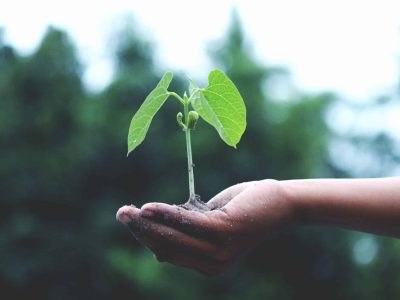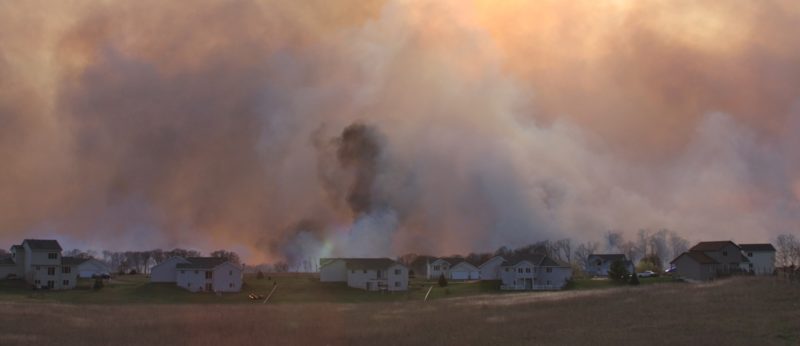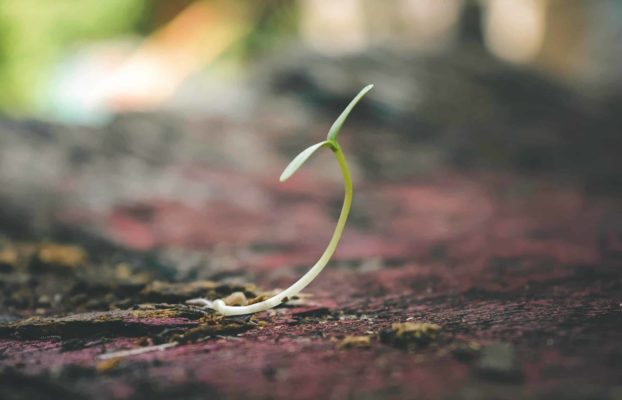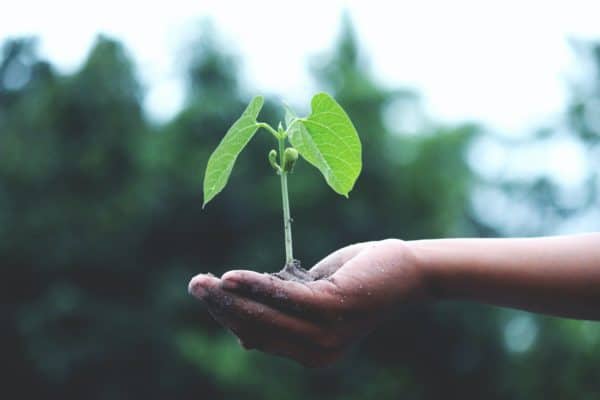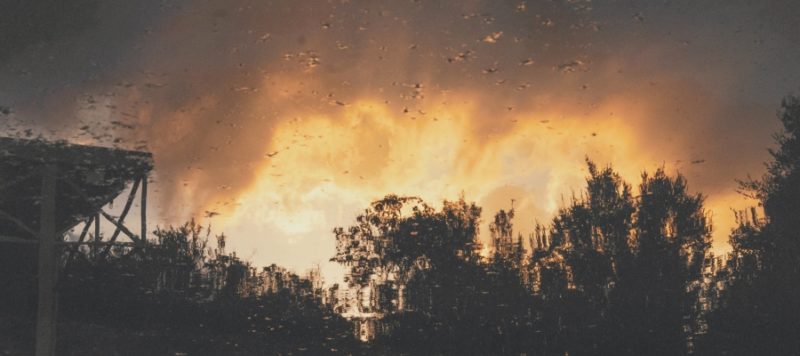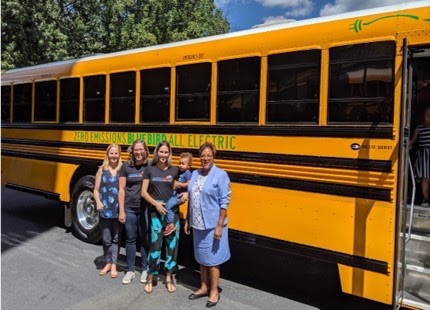THE SIXTH ASSESSMENT REPORT of the Intergovernmental Panel on Climate Change (IPCC) is clear: human-caused carbon dioxide emissions, particularly from fossil fuel combustion, have warmed the climate in every inhabited region across the globe. In the U.S., communities are now facing more frequent and severe heat waves, wildfires, smoke days, drought, and extreme weather events. These climate threats are putting our health, infrastructure, and economy at risk like never before.
At C-Solutions, we focus on understanding the impacts of climate change on human health and implementing solutions to help protect communities. September 2, 2021 marks one year since our center was officially launched. Here are some of the ways we’ve made a difference in Year 1:
RESEARCH
Better understanding the relationship between COVID-19 deaths and traffic-related air pollution in LA County
C-Solutions faculty and student researchers published a study quantifying the link between air pollution and COVID-19 deaths in Los Angeles County. They found Los Angeles neighborhoods with the worst air pollution saw a 60% increase in deaths from COVID-19 compared with communities with the best air quality. Neighborhoods with high proportions of Latino/a and Black residents tend to have higher levels of air pollution, and the link found in this study may help explain why these groups suffered disproportionately from the pandemic. Demonstrating that traffic pollution increases COVID-19 deaths is an important step to addressing health inequalities in Los Angeles and nationwide. The study earned Dr. Jerrett and Dr. Zhu the 2021 UCLA Green Gala Faculty of the Year Awards for helping to advance UCLA’s goal of developing sustainable interventions that center on improving equity, diversity and inclusion in the Los Angeles region.
Identifying communities exposed to harmful pollutants from oil and gas flaring
Flaring, the intentional burning of waste gases during the drilling and oil production process, has been on the rise in the U.S. over the past decade. Flaring contributes to global warming and releases toxic air contaminants, noise, and light pollution. Dr. Lara Cushing published new research that estimates over half a million people live within 5km of flaring and are thus exposed to harmful pollutants. Black, indigenous, and people of color are disproportionately exposed, raising community health and environmental justice concerns. Prior work by Dr. Cushing and her colleagues linked living within 5km of flaring during pregnancy to higher preterm birth rates among Latina women in Texas’s Eagle Ford Shale. Identifying which communities are most vulnerable to the impacts of oil and gas flaring improves our ability to target policies and interventions to address existing health disparities.
Increasing park equity to improve health and build resilience
Parks and green spaces are essential community infrastructure, providing many physical and mental health benefits. Parks provide opportunities for physical activity, social connection, and mental relief. They filter air, remove pollution, buffer noise, and cool temperatures down. But not all communities have access to safe, well-maintained parks and green spaces. According to the Trust for Public Land, 100 million people in the U.S.—including 28 million children—don’t have a park or green space within a 10-minute walk from their home. Dr. Michael Jerrett conducted new research that suggests increasing parks and green spaces could lead to significant population-level increases in life expectancy, widely considered an important indicator of overall health. The research was done in LA County, where over 50% of residents (5 million out of 10 million) live in neighborhoods that have little or no access to parks. Many of these neighborhoods have a higher proportion of Latino/a, Black, and lower-income residents. This study is the first of its kind in the United States, and among the first in the world to examine the link between park access and life expectancy, marking an important step towards increasing park equity as a way to improve population health.
Equipped with the data from this study, C-Solutions partnered with Prevention Institute and the UCLA Center for Occupational and Environmental Health to present a free webinar series about the unequal distribution of parks and green spaces in urban areas and how this contributes to health inequalities. The group has also provided the Advocacy Toolkit for Park Equity, Life Expectancy, and Power Building for free online to empower anyone who would like to advocate for more equitable investments in park infrastructure in their community.
COMMUNITY PARTNERSHIPS
Protecting the most vulnerable communities from extreme heat
Dr. David Eisenman is part of a team of 10 UCLA professors that has earned a $956,000 award for a multidisciplinary project that will protect the most vulnerable Los Angeles residents from rapidly increasing and intensifying extreme heat days. The project, titled Heat Resilient L.A., determines where and when people moving around the city are most vulnerable to the effects of extreme heat so we can assess which communities most need cooling interventions. Based on their findings, the team will then design new cooling structures and work with local stakeholders to determine where they should be installed. The team has designed a prototype structure that, in addition to providing shade, uses a combination of radiant and evaporative cooling technologies to provide “passive cooling” for those nearby. The researchers are engaging directly with communities to produce the best possible design for the cooling structures and choose the best possible locations.This innovative project stands out for its strong focus on equity and community engagement, and its use of devices other than shade and trees to provide cooling for local hot spots. It will bring relief to Los Angeles neighborhoods that suffer the most from extreme heat.
Building communities’ adaptive capacity through resilience hubs
Dr. Brian Cole and Dr. David Eisenman are part of a team awarded $25,000 to develop a model for resilience hubs in Los Angeles, called LA Oases. The team’s model for community-based resilience hubs is designed to be adaptable and scalable to the climate threats and community priorities of the neighborhoods they would serve. Going beyond the traditional focus of resilience hubs, which typically support communities during disruptions and disasters, LA Oases serve as multi-benefit go-to locales for day-to-day needs: they are places where, for instance, residents can charge or borrow zero-emissions transport devices (such as e-bicycles), use free wifi, grow or buy freshly grown fruit and vegetables—as well as find safety, resources, and services in the event of a heat wave, power outage, drought or earthquake. The LA Oases team’s creation of a model resilience hub is a critical first step in helping communities to build self-reliance in the face of climate threats while improving social cohesion and equity.
EDUCATION
Educating the public about the health effects of climate change and solutions to protect communities
One of our goals at C-Solutions is to share the scientific evidence of the health effects of climate change in an accessible format and to help people feel empowered to do something about it. To this end, C-Solutions partnered with UCLA Extension to offer a free, publicly available course on climate change and health over three weeks in July 2021. Titled “Public Health Impacts of Climate Change and Steps Toward Protecting Our Communities,” the course was taught through a combination of real-time virtual meetings with center faculty, weekly readings, activities, and discussion boards. The course included an overview of the documented and expected health impacts of climate change, the factors that determine people’s levels of risk and exposure, and the ways that climate change exacerbates existing health inequalities. The course also covered tested solutions for mitigating and adapting to these adverse effects. The course had nearly 200 participants, and a course evaluation administered at the end showed a high level of satisfaction with the content. Many participants expressed that the course inspired them to share the information they learned with their family members, friends, colleagues, and others in their community and to take action against climate change.
Sharing best practices for teaching K-12 students about climate change
Ultimately, children’s lives and futures will be the most disrupted by climate change. A key part of our mission is to educate the next generation about the problem we are facing collectively and give them the tools to change our current trajectory. In partnership with faculty from the UCLA School of Education, C-Solutions is creating professional development opportunities for K-12 educators to learn strategies and techniques for teaching students about climate change, its effects on health, and what they can do about it. We are currently developing a real-time webinar that will give teachers an opportunity to learn from our experts and community partners about the overlapping themes of extreme heat, health equity, and ways to help communities become more resilient to climate change and protect those who are most vulnerable. Participating teachers will be provided with lesson plans and activities they can use in the classroom to expand students’ understanding of climate issues while also empowering them to take action.
EVIDENCE TRANSLATION AND COMMUNICATION
Reports
Providing a comprehensive look at struggling water systems in California and how to help them
Climate change is intensifying the problem of water scarcity and declining water quality. Much of the Western U.S., including California and the Southwest, is now in a severe drought of historic proportions. Dr. Greg Pierce recently published the 2021 Drinking Water Needs Assessment with the California Water Boards, offering the first-ever comprehensive look at California water systems that are struggling to provide safe drinking water to communities and how to help them. It identifies failing water systems and those at risk of failing, estimates the cost of short- and long-term solutions for these systems, and analyzes the funding gap and affordability challenges that may be barriers to provide safe drinking water to every resident. The report sets a path toward clean drinking water for all Californians.
Raising the issue of health effects from wildfires and wildfire smoke
Climate change is leading to longer fire seasons, with more frequent, back-to-back, and persistent wildfire events. This not only poses a threat to communities threatened by the blaze itself; these changes can lead to smoke exposure for weeks or even months in communities far from the fires themselves. Following a meeting at the National Academies of Sciences, Engineering, and Medicine, UCLA C-Solutions has partnered with Climate Resolve to shed light on the mental and physical health impacts of wildfires and smoke. Led by Dr. David Eisenman, the team published a report on the mental health impacts of wildfire smoke, “solastalgia” from wildfires, and impacts on civilian and inmate firefighters. Solastalgia is defined as the lived experience of stress from the loss of a familiar landscape and can overlap with post-traumatic stress disorder (PTSD), anxiety, grief, and other emotional and mental impacts of climate change and natural disaster. The team found that there is little existing research focusing on the mental health impacts of wildfire smoke, especially the impacts on inmate firefighters and residents who do not evacuate during a fire and instead stay to protect their home. This report can help spur more research into these vulnerable populations as the threat of wildfires becomes more severe.
Policy Advocacy
Providing evidence in support of the Extreme Heat and Community Resilience Program to the California State Senate
In June 2021, Dr. Eisenman testified to the California State Senate Committee on Natural Resources and Water in support of Assembly Bill 585 (AB 585), which establishes the Extreme Heat and Community Resilience Program. Under this bill, the Governor’s Office of Planning and Research will help communities throughout California to implement climate plans at the local, regional, and state levels. The bill also establishes a specific fund in the state treasury to award grants for implementing projects focused on responding to adverse effects of extreme heat. Dr. Eisenman’s testimony highlighted the impact of extreme heat on individual and community health and opportunities for adapting to this threat.
Media Appearances
C-Solutions researchers have been called upon to provide their climate and health expertise by the following national and local news media outlets:
- New York Times
- Los Angeles Times
- The Hill
- U.S. News
- Southern California News Group
- NBC Los Angeles
- KPCC Southern California Public Radio
- Fox 11 Los Angeles
- American Heart Association News
To read, watch, or listen to these interviews, please visit the C-Solutions News page.

